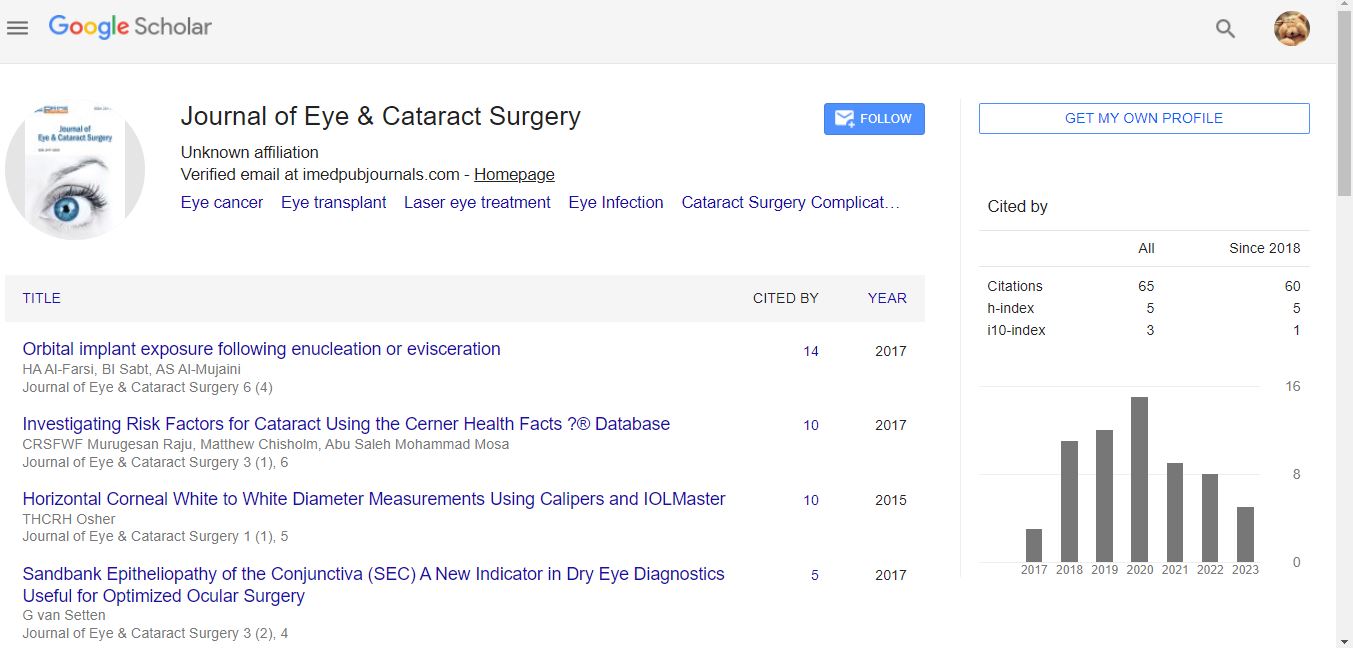Commentary - (2024) Volume 10, Issue 4
Eye Infection: Causes, Symptoms, Treatment, and Prevention
Johanna Katharina*
Department of Bioengineering, University of Pittsburgh, USA
*Correspondence:
Johanna Katharina,
Department of Bioengineering, University of Pittsburgh,
USA,
Email:
Received: 02-Dec-2024, Manuscript No. IPJECS-25-22559;
Editor assigned: 04-Dec-2024, Pre QC No. IPJECS-25-22559 (PQ);
Reviewed: 18-Dec-2024, QC No. IPJECS-25-22559;
Revised: 23-Dec-2024, Manuscript No. IPJECS-25-22559 (R);
Published:
30-Dec-2024, DOI: 10.36648/2471-8300.10.4.35
Description
The human eye is a delicate and essential organ that allows us
to see the world around us. However, like any other part of the
body, it is susceptible to infections caused by bacteria, viruses,
fungi, and allergens. Eye infections can be mild and self-limiting
or severe and require immediate medical intervention to
prevent vision loss. This article explores the causes, symptoms,
types, treatments, and preventive measures related to eye
infections. Understanding these factors can help individuals
protect their eyes and maintain good ocular health. An eye
infection occurs when harmful microorganisms, such as bacteria,
viruses, or fungi, invade any part of the eye or its surrounding
tissues. These infections can affect the conjunctiva (the thin,
transparent membrane covering the white part of the eye), the
cornea, the eyelids, or the tear ducts. Depending on the cause
and severity, eye infections may result in redness, swelling,
discharge, pain, and vision disturbances. Caused by bacteria
such as Staphylococcus aureus, Streptococcus pneumoniae,
and Pseudomonas aeruginosa. Commonly spread through
contaminated hands, contact lenses, or exposure to polluted
water. Can lead to conditions like bacterial conjunctivitis and
corneal ulcers. Caused by viruses such as adenoviruses, Herpes
Simplex Virus (HSV), and Varicella Zoster Virus (VZV). Often
spread through respiratory droplets or direct contact with
infected individuals. Common viral eye infections include viral
conjunctivitis and herpes keratitis. Less common but can occur
due to exposure to fungi like Fusarium or Candida. Can result
from eye trauma, prolonged use of contact lenses, or a weakened
immune system. Fungal keratitis is a serious condition that can
lead to vision loss if not treated promptly. Caused by parasites
like Acanthamoeba, which can be found in contaminated
water. Contact lens wearers are at a higher risk of developing
Acanthamoeba keratitis. Occur when the eyes react to allergens
such as pollen, dust, pet dander, or certain eye drops. While
not an infection, allergic conjunctivitis can cause significant
discomfort and redness. Exposure to smoke, chemicals, and
pollutants can irritate the eyes and lead to infections. Poor
hygiene, such as rubbing the eyes with dirty hands, can introduce
harmful microbes. Eye infections can be classified into different
types based on the affected area and the causative agent. One
of the most common eye infections, affecting the conjunctiva.
Can be caused by bacteria, viruses, or allergens. Symptoms
include redness, itching, excessive tearing, and discharge. An
infection of the cornea, the transparent layer at the front of
the eye. Can be bacterial, viral, fungal, or parasitic. Symptoms
include eye pain, blurred vision, light sensitivity, and discharge.
Inflammation of the eyelids, often caused by bacterial infection
or blocked oil glands. Eye infections are common but can be
effectively managed with early diagnosis and proper treatment.
Understanding the causes, symptoms, and preventive measures
can help individuals protect their vision and avoid complications.
While mild infections may resolve on their own, more severe
cases require medical attention to prevent long-term damage.
Practicing good hygiene and taking precautions can significantly
reduce the risk of eye infections, ensuring healthy eyesight for
years to come. If you experience persistent eye discomfort or
vision changes, consulting an eye specialist is the best course of
action.
Acknowledgement
None.
Conflict Of Interest
The author's declared that they have no conflict of interest.
Citation: Katharina J (2024) Eye Infection: Causes, Symptoms, Treatment, and Prevention. J Eye Cataract Surg. 10:35.
Copyright: © 2024 Katharina J. This is an open-access article distributed under the terms of the Creative Commons Attribution License, which permits unrestricted use, distribution, and reproduction in any medium, provided the original author and source are credited.

